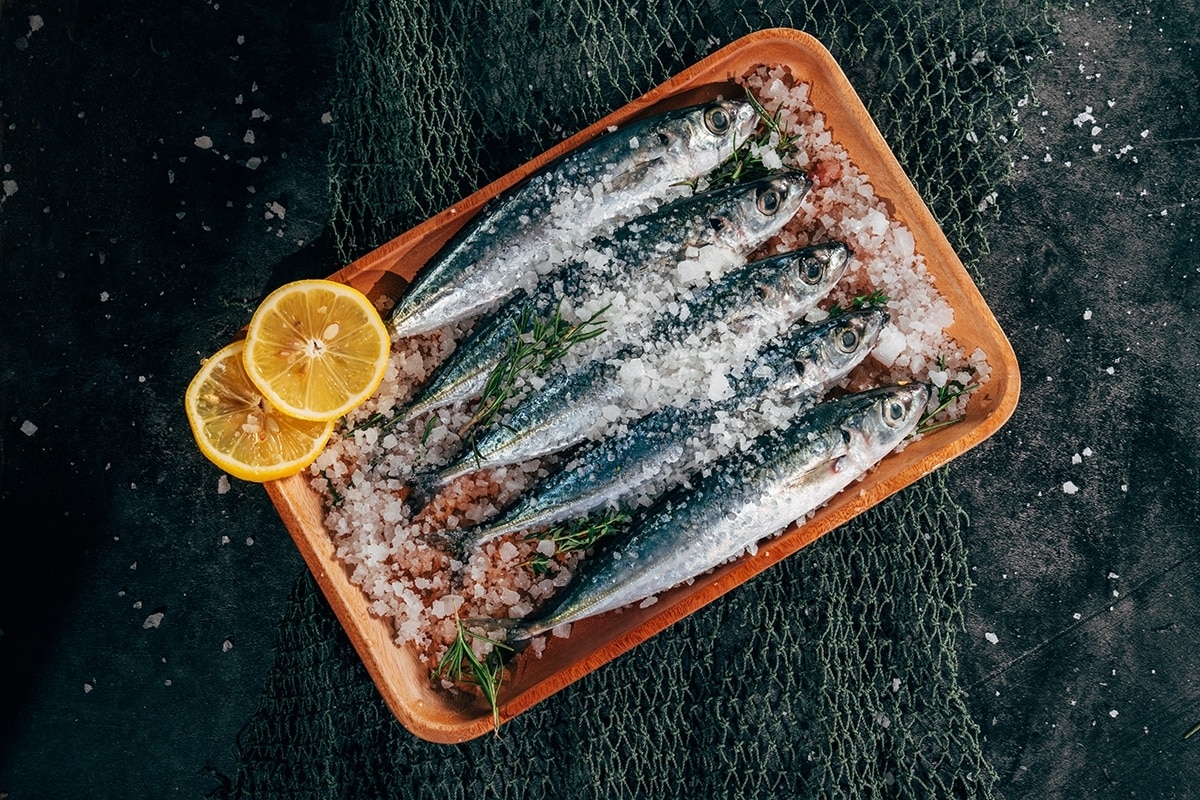There are a lot of stories about omega-3 but how do you know which ones are true and
which ones are false? We discuss the most common myths concerning omega 3.

I do not like fish. That’s not a bad thing, because I can get all my omega-3 fatty acids from nuts, seeds and green vegetables.
Mythe-alert!
That’s not right. Don’t be fooled by the term ‘omega-3 fatty acids’, because one omega-3 fatty acid is not the same as another. Your body needs three types of omega-3 fatty acids: alpha-linoleic acid (ALA), eicosapentaenoic acid (EPA) and docosahexaenoic acid (DHA).
ALA is essential for a good balance between omega-6 and omega-3 in the body. EPA and DHA are the fish fatty acids that are very beneficial for the normal functioning of the heart. DHA also helps to optimise the workings of the brain and the eyes, and plays quite a considerable role in the development of these organs in the foetus and infants. Nuts, seeds and green vegetables contain ALA, but not EPA or DHA. The only exception among green plants is seaweed. Not exactly a big hit in terms of Western cooking, nor a high flyer with regard to EPA+DHA content. A fresh portion of green seaweed weighing 200g contains no more than 10mg of EPA+DHA. If you only eat ALA, your body tries to convert this omega-3 fatty acid into EPA and DHA, but is not sufficiently successful. Only 0.2% to 8% is converted into EPA and only an insignificant 0.05% (or less) into DHA. This is why you still need to find a direct source of EPA and DHA to supplement your diet sufficiently. EPA and DHA are only found in oily and semi-fatty fish, crustaceans and shellfish, and various kinds of seaweed (red, green, brown) and in fish oil or algae oil. But don’t worry, high-quality fish oils do not have a fishy taste.

Every day I eat different foods enriched with omega-3 fatty acids: a bowl of cereals, an egg, ‘proper’ butter on my sandwich, meat,… so I get enough omega-3 fatty acids.
Mythe-alert!
A reference to ‘Omega-3’ on a package can give you a mistaken feeling that you are getting enough omega-3 fatty acids with your food. Take a close look at which omega-3 it is: is it ALA, EPA or DHA? Many breakfast cereals are only enriched with essential ALA, but do not contain the heart-friendly EPA and DHA.
Foodstuffs that are indirectly enriched with omega-3 fatty acids do not offer any guarantee that they will cover your omega-3 requirement. This is the case with eggs, ‘proper’ butter and meat if the chickens, cows or other animals are fed with linseed (a source of ALA), algae or fish oil (sources of EPA/DHA). In order to get a daily heart-friendly portion of 1g EPA+DHA, you would have to eat, every day, 15 eggs, 1.7kg ‘proper’ real butter or 25kg of pork. Not realistic daily quantities! In the case of directly enriched foods, it is advisable to check on the relationship between omega-6 and omega-3 fatty acids. The Western diet contains too much omega-6 compared with omega-3, mainly due to the high consumption of meat (source of the omega-6 fatty acid arachidonic acid or AA) and vegetable oils, such as safflower, sunflower, maize, sesame and peanut oil, which are processed in many products as hidden fats (sources of omega-6 fatty acid, linoleic acid or LA). We owe it to our health to consume more omega-3 fatty acids to correct the omega-6/omega-3 balance. As a consumer, you can see that you need to check the nutrition labelling very carefully: omega-3, omega-6, ALA, LA, AA, EPA, DHA. If you opt for a high-quality fish oil supplement, then you have an easy way of keeping control over your omega-3 intake of heart-friendly EPA and DHA and contributing to a correction in the omega-6/omega-3 balance. The choice is yours.

I eat fish regularly, so I get enough omega-3 fatty acids.
Mythe-alert!
The painful reality regarding pollution of the sea nowadays forces us to eat fish only once per week. This is the recent advice from the official authorities.
Even farmed fish are fed on fishmeal, which again originates from the sea. Fish consume pesticides, PCBs, dioxins and heavy metals from the polluted seas in which they live. The degree of pollution varies by region and type of fish. It is advised to get a lot of variety in the species of fish and their place of origin in order to consume as little of the polluting material as possible. But then, what will be your intake of omega-3 fatty acids? The content of EPA+DHA is different for each fish species. Whether you receive enough omega-3 fatty acids with your weekly portion of fish depends on the type of fish and your personal needs. For a minimum daily heart-friendly portion of 250mg EPA+DHA, the single weekly meal could be made up of a 100 to 200g portion of mackerel, sardines (summer catch), herring, anchovy, salmon or tuna. Take care about the preparation method, because deep-frying (heat) breaks down the omega-3 fatty acids. You will not get sufficient omega-3 fatty acids with other fish such as turbot, Indian mackerel, sole, sardines (winter catch) cod, pollock or lemon sole. Since you are advised to get a wider variety of fish species because of pollution, and because the ideal heart-friendly daily portion can be up to 1g EPA+DHA, it is useful to top-up your fish intake with a pure omega-3-supplement. Whoever is looking for support regarding their triglyceride level or for blood pressure, needs on a daily basis a high amount of 2g or 3g EPA+DHA respectively. This is only possible by using a high-dose omega-3 supplement. According to the European Food Safety Authority (EFSA) you can add an extra intake of omega-3 fatty acids by means of a supplement to provide up to 5g EPA+DHA per day.

Omega-3 fatty acids from food supplements are less well absorbed than omega-3 fatty acids from fish.
Mythe-alert!
This is not true. Omega-3 fatty acids are fats. They should best be included in a meal with high fat content, whether or not they come from a food supplement or from fish. The reason for this is simple: a meal with high fat content sets the fat digestion system on ‘high’. A maximum efficiency in digesting fat leads to an optimum intake of the omega-3 fatty acids.

Why should I take fish oil supplements? These are just like the fish themselves and are polluted with harmful substances, such as PCBs, dioxins, heavy metals and radioactive substances.
Mythe-alert!
During the purification procedures for edible fish oil, the harmful substances are removed. Also, a fish oil supplement must meet strict European regulations that allow only traces of contaminants.
The great advantage of a production method such as supercritical CO2 extraction is the use of natural CO2, in which the pure fish oil dissolves very well, whereas that is not true for the contaminants. This makes it possible to separate the non-soluble fraction containing PCBs, dioxin and heavy metals from the fish oil.

I eat healthily, so I don’t need any food supplements.
Mythe-alert!
Have you wondered if you are sufficiently critical on your own behalf? The most recent food consumption surveys show that the recommendations on omega-3 in terms of EPA+DHA and on fish consumption are not being met by many people.
The definition of ‘healthy eating’ should be approached in a more differentiated manner with regard to the omega story. Our eating habits have always undergone an evolution through history. Spurred on by the food industry there emerged, some 200 years ago, a turnaround to a dramatically high intake of omega-6 fatty acids and an equally large reduction in the consumption of omega-3 fatty acids: the balanced ratio of 1/1 between omega-6/omega-3 became an unbalanced ratio of 20/1. This mismatch is regarded by nutritionists as an important reason why things sometimes go wrong with the physiology of our bodies. For some 4 million years, in the hunter-gatherer era, our genes adapted to a diet that did not change. To produce relevant changes in human genes, the turnaround 200 years ago is too recent and too abrupt. The nutrition sector is therefore making efforts to offer once again foods with more omega-3 to correct this matter of the omega-6/omega-3 ratio in our diet to an acceptable figure of 5/1. This is closer to the ratio in our historical diet to which our genes are adapted. Now it is only a question as to whether we can eat in a 100% healthy manner with the omega level that we have available. For an ideal heart-friendly daily ration of 1g EPA+DHA, it would already be useful to enhance the consumption of foods enriched with omega-3 or fish by using a pure omega-3 supplement. You can read about the reasons for this in our FAQ 2 and 3.

We don’t need omega-3 at all. In the past, it was a short-lived fad, but nothing more.
Mythe-alert!
Did you know that the number of scientific publications on the effects of omega-3 fatty acids in humans is now over 25,000? And the research is still going on. That is not surprising because omega-3 fatty acids are essential for the human body, they guarantee the smooth running of a number of physiological functions.
We can no longer speak about a fad. It is normal that such a widely-studied nutritional component has its ups and downs in popularity. However, the fact that omega-3 fatty acids are well established on the health front cannot be better illustrated than by the many healthy claims which the European Food Safety Authority (EFSA) has acknowledged after a very thorough evaluation of all the study programs. The recognised health benefits are as follows: For adults: EPA and DHA support the normal functioning of the heart (from 250g/day) are good for maintaining a favourable triglyceride level (at 2 g/day), and help to maintain healthy blood pressure (at 3g/day). DHA plays a role in maintaining healthy heart function and good vision (at 250 mg/day). For the unborn child and infants: The intake of DHA by the mother contributes to the normal development of the brain and eyes in the foetus, and in breast-fed infants (at 200mg/day in addition to the standard 250mg EPA+DHA/day). The intake of DHA contributes to the normal visual development of infants up to the age of 12 months (at 100mg/day)
Do you want to know more about what we represent?

